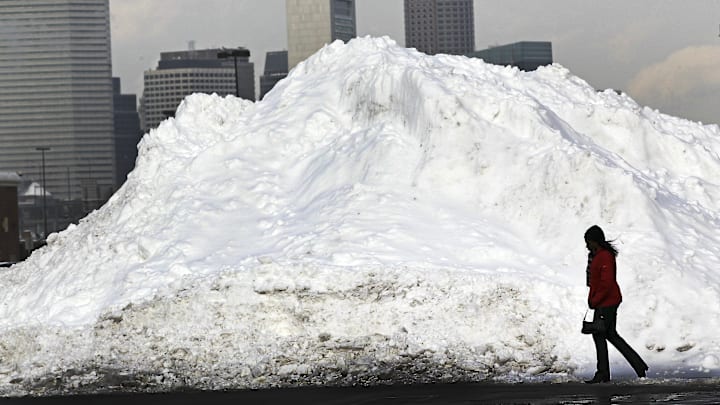Those in snowy climates have grown accustomed to seeing great mounds of the white stuff shunted off to one side in parking lots and sidewalks. Even as the temperature rises and the sun peeks out, a curious thing persists: These snow mounds refuse to melt. They sit proud and dirty, like filthy little monuments to bad weather. Why?
The Science Behind Everlasting Snow Piles
According to Boston.com, the stubborn snow mountains are resistant to nicer weather thanks to a combination of factors. First and foremost, there’s latent heat of fusion, or the energy needed to turn water from a solid to a liquid. That's different from the temperature: For a huge pile of snow, you need energy (and time), not just rising temperatures, similar to how an ice cube won't immediately melt in your hand.

That’s because of reason two: pile thickness. Snow mounds are generally human-made creations, tossed aside and away from traffic and pedestrians in ever-increasing amounts. The pile becomes dense and heavy, and the snow closer to the surface begins to act as an insulator for the snow buried deeper down. The compacted snow requires more energy—not just a sunny day—to dissipate.
You May Also Like ...
- 15 Surprising Facts About Snow
- What’s Really Happening When You “Smell” Snow?
- 6 of the Strangest Snow and Ice Formations in Nature
Add Mental Floss as a preferred news source!
What Happens to the Giant Parking Lot Snow Piles?
The problem sometimes get to the point that cities will haul snow mounds away from heavily trafficked areas, leaving them to melt in empty parking lots.

If you’re hoping for unsightly snow to disappear and don't have a dump truck handy, the best thing to do is to hope for some rain, which can pierce snowbanks and effectively drown them. The wetter they become, the worse they are at insulating themselves from melting.
These snow piles can stick around long after the last winter storm has blanketed a city. The massive snow mound that formed in Boston after a particularly snowy winter in 2015 lingered until July.
Of course, there is one upside to snow this persistent: It means your snowman is likely to remain standing.
A version of this story originally ran in 2022; it has been updated for 2025.
